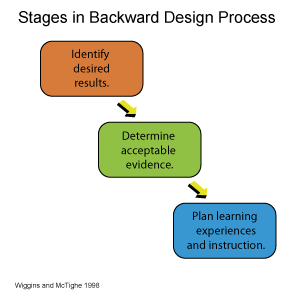
Backward Design
What is the best route for your students to take?
The best approach is to plan your instruction by starting at the instructional destination and working backwards. This is the backward curricular design methodology proposed by Wiggins and McTighe (1998):
Why do we describe the most effective curricular designs as "backward"? We do so because many teachers begin with textbooks, favored lessons, and time-honored activities rather that deriving those tools from targeted goals or standards. We advocate the reverse: One starts with the end-the desired results (goals or standards)—and then derives the curriculum from the evidence of learning (performances) called for by the standard and the teaching needed to equip students to perform. (p. 8)
What Wiggins and McTighe refer to as "evidence of learning (performances) called to by the standard" are the core competencies identified in Pennsylvania's curriculum framework. By starting with these core competencies, teachers can create meaningful assessments and learning objectives from which to base instruction. There may be other concepts that are not addressed by the standards that are important for your students to learn, and there are many competencies that could be also be added to the list. Using a backward curricular design enables teachers to make better choices in adapting the curriculum and instruction to their students' needs.
